|
| |
| December
2005 |
| SBG
Split Twenty
years on |
Part
1 |
| In 1985, the
Scottish Bus Group comprised of seven companies. Nothing much
had changed for years, but with the twin impending threats of
de-regulation and privatisation looming, now seemed the time for a
shake-up. The plan was simple, but not foolproof - create
smaller, leaner companies ready for the brave new world. Three
of the larger companies would basically be split in two - Strathtay being
born from Northern, Clydeside coming out of Western, and Lowland being the
Borders area of Eastern. The final company was Kelvin - a
mish-mash of bits of Midland, Central and Eastern around
Glasgow. How did it work out ? Did they survive
? Read on to find out the answers .. |
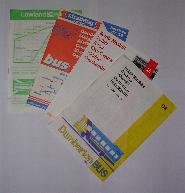 |
| |
| Strathtay |
How
did it start ?
Strathtay was formed from a mixture of Midland and Northern depots to
serve the area around the city of Dundee. It inherited depots
at Crieff, Perth and Pitlochry from Midland and those at Dundee,
Blairgowrie, Arbroath, Forfar and Montrose from Northern. It
adopted an unusual livery of orange and blue, although a white relief was
soon added (bottom right). The fleet was a mixed bag
including vintage Fords and elderly Ailsas, as well as the usual fare of
Leopards (bottom left) and Fleetlines. |
Where
did it go wrong ?
In fact, Strathtay are probably the most successful of all the four new
companies established in 1986. They were on a hiding to
nothing, when they tried to compete with Stagecoach on their own territory
in Dundee and Perth. Despite being the newcomer Stagecoach won
the battle, deploying a fleet of minibuses against Strathtay's
Routemasters. Even the return of the Perth City livery could not
prevent the incumbent from surrendering the Perth city routes to
Stagecoach (above right). |
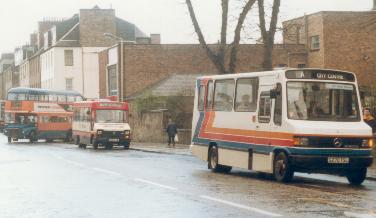 |
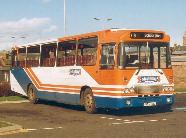 |
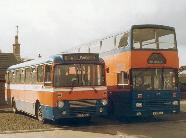 |
What happened
next ?
After the battle with Stagecoach, Strathtay concentrated on its rural
routes where it has remained healthy. When the SBG companies
were privatised in the mid 1990's they were bought by Yorkshire Traction.
What are they now ?
The influence of the parent group is apparent in the vehicle buying policy
with a wide selection of types in service. The |
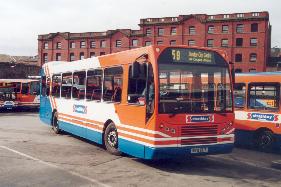 |
| fleet has gradually been
replaced by a variety of second hand stock, new vehicles and re-bodied
ones (above right) with no vehicle knowingly wearing the same
livery as another. The depots at Crieff and Pitlochry have
been closed, but in contrast the bus station at Dundee has recently been
refurbished. |
| Strathtay |
| |
| Click to
enlarge photos. |
| |
| Photo
Facts (top to bottom) |
 | Stagecoach G270TSL, an
Alexander bodied Mercedes minibus, followed by a Stathtay Dodge
minibus in Perth City livery, followed by a Strathtay Routemaster in
Perth in December 1989. |
 | Strathtay SL23 (VOH640), an
Alexander T-type Leopard, in Arbroath bus station in April
1990. This was formerly NPE64 (CRS64T) in the Northern
fleet. |
 | Strathtay SL64 (ULS326T), an
Alexander bodied Leopard, bought second-hand from Kelvin and SO11
(C111BTS), a new Alexander bodied Olympian at Forfar depot in
April 1990. |
 | Strathtay 430 (670CLT), one of
six Leyland Tigers rebodied by East Lancs, in Dundee bus station in
April 2001. |
|
| |
| |
| Lowland |
 |
How
did it start ?
For many years the Borders operation of SMT, and then Eastern Scottish,
had acted autonomously, so a natural divide already existed.
Eastern was split in two with Galashiels, Peebles, Kelso, Berwick,
Hawick and Jedburgh passing to the newly formed Lowland.
The Borders had traditionally been home to lightweight vehicles
such as Bedfords, but by the mid-80’s there had been considerable Seddon-creep
resulting in a fleet almost entirely powered by Gardner.
The livery was also uncompromising.
With a mere tweak of a paintbrush the new colours were born –
Eastern’s cream being replaced by a bold but not necessarily beautiful
yellow (lower right). |
What happened
next ?
Lowland started confidently by diversifying into coaching in a big way,
supplying vehicles for Citylink (lower left), and leasing
all-over-white vehicle for summer coaching activity.
It bought a handful of new vehicles in the shape of unusual
Alexander Q-bodied Tigers (upper right), and even regained the
tendered Scottish Border Rail Link it had lost to McEwan.
Sold to its employees in 1990, it was subsequently bought by GRT in
1994, which later became First.
Surely nothing could happen to this distinctly rural operator in
the hands of a big bus group ? |
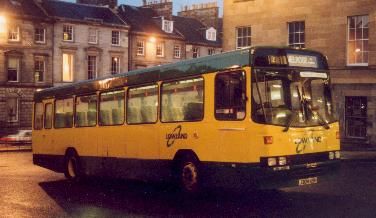 |
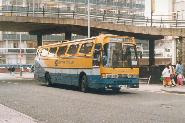 |
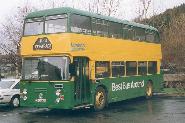 |
Where
did it go wrong ?
First invested almost nothing in Lowland, so more and more ancient
vehicles came to be found in Borders depots (right).
It lost the main Kelso to Edinburgh service to Munro of Jedburgh,
who gradually nibbled away at Lowland’s other tendered routes.
Eventually First had to call it a day, and shut Kelso, Peebles,
Jedburgh and Hawick depots in 2003, having already closed Berwick after a
fierce battle with Arriva. |
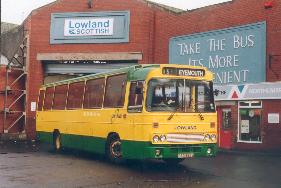 |
What are they now ?
Closing so many depots could be deemed to be careless, however First
fight on. The latest round of tender awards has seen it gain some operation once
again on the Kelso to Edinburgh service, and it still provides many of the
main trunk services in the Borders such as the (62) Melrose to Edinburgh
and (60) Galashiels to Berwick (top).
Despite having only one major remaining operating base, who can say
that Lowland won’t survive and flourish again ? |
| Lowland |
| |
| Click
to enlarge photos. |
| |
| Photo
Facts (top to bottom) |
 | First Edinburgh 65696 (SN53KHL),
a Wright bodied Scania, leaving Greenlaw on the (60) service from
Berwick-Upon-Tweed to Galashiels in December 2003. |
 | Lowland 304 (J304ASH), one of
four Alexander Q-bodied Tigers delivered new, outside St. Andrews bus
station Edinburgh in December 1991. |
 | Lowland 519 (PSU319), a Duple
bodied Tiger, at Manchester Chorlton St, on National Express service
(371) from Nottingham to Glasgow. Lowland broke ranks with
other Scottish Bus Group companies by operating for National Express
after they and Citlylink had gone their own ways the previous year. |
 | Lowland 854 (GSC854T), a
standard ECW bodied Fleetline, at Peebles depot in December 1987. |
 | Lowland loved Seddons, but Clydeside
didn't. So when the West of Scotland company started to
dispose of them, Lowland snapped some up. One example - 265
(DSD965V) - a well travelled former Johnstone based vehicle is
seen at Berwick bus station in September 1991, before it was
demolished and Lowland left town. |
|
| |
| Clydeside and Kelvin to follow next month .. |
| |
|